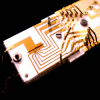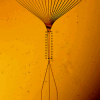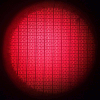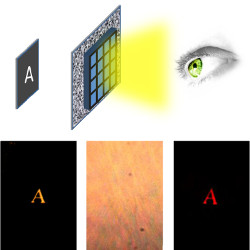-
Viewpoint on 'IONS'
Viewpoint on 'Scientific Literacy'
- Proudly sponsored by
-


-
The Dawn of Scalable Quantum Computers

How close are we to the quantum computational revolution? Current precursors of quantum computers cannot be scaled efficiently. Now, researchers have realized a new setup that can be scaled more easily than ever before.
-
The Random Walk towards Quantum Computing

Subtle quantum effects will be at the heart of the quantum computers of the future. Very few existing setups, however, offer the necessary stability and control to exploit such effects at the moment. Arrays of waveguides meet this challenge.
-
The Future of Barcodes

Thanks to barcodes, computers can extract a lot of information on our everyday lives. A new technology by MIT, the Bokode, greatly enhances barcode technology, from interactive shopping to inexpensive motion capture.
Volume 18 Story 3 - 6/11/2012

Extraordinary vision powers, invisibility, superhuman strength… For generations, all these unearthly powers, and many more, have had kids all over the world dreaming about superheroes — and about maybe, one day, becoming one. Currently, science and technology are bringing many of the ideas behind superpowers, such as cloaking and levitation, down to more earthly levels. In superman-like fashion, a recent experiment carried out by Ori Katz, Eran Small and Yaron Silberberg at the Weizmann Institute of Science in Israel, has demonstrated the ability to peek through a turbid material using standard illumination light alone, such as the light that comes from a light bulb or from the sun.
Superman can see through turbid material. Why, then, can’t we? The answer lies in the way light travels through materials. Typically, the light that we see bounces directly off our surroundings to our direction. Let’s imagine this light as a series of parallel lines that travel straight to our eyes from the objects in view. What if, between us and those visible objects, a turbid medium were interposed, such as a thin sheet of white paper or the frosted glass used, for example, in the doors of shower cubicles? Every one of these parallel light lines will take a very tortuous and complex path inside the turbid medium, depending on many factors, such as the exact entering point, or the thickness of the medium. As a result, after crossing through the material, the once parallel lines become all mixed up, and… a big bright blur can be seen, instead of the image of the original object!
Despite this light scrambling process induced by the turbid material, the Israeli researchers have been able to reconstruct the image of an object illuminated with a standard light bulb. The trick? A device called Spatial Light Modulator (SLM), placed just after the turbid medium. An SLM is a screen made up of many tiny units (pixels), each one of which can independently modify the propagation properties of the light passing through. Thanks to the SLM, Katz and colleagues were able to learn, using a computer optimization method, how to compensate for the scrambling process the light went through in the turbid medium, thus regenerating the image of the original object onto a camera.
Other research groups had previously shown similar reconstruction techniques to work mainly with laser light — also known as coherent light — which has very highly desirable properties that standard illumination — or incoherent — light does not possess. "Our main, novel finding is that standard incoherent light sources, such as white light lamps and fluorescent probes, can be used for imaging through scattering media," Katz explains. "In all of the works to date, monochromatic or short-pulsed lasers were used to achieve this goal. The use of incoherent light does not only simplify the system and make it more compatible with real-world scenarios, but it also allows for real-time imaging, whereas all previous works used computerized reconstruction and raster-scanning to produce the image." And he adds: "The fact that incoherent light works so well came, admittedly, as small surprise — yet a wonderful one! We knew it should work, but did not realize how well it would."
The applications for this technique are many, and limited only by one’s imagination. As Katz puts it, this technique "may allow for the study of biological samples previously inaccessible by optical imaging, such as imaging through thin egg shells to study embryonic development. Moreover," he adds, "we have demonstrated that with the same technique one can look at the light reflected from a wall and see what is happening around the corner." Allard Mosk, at the University of Twente in the Netherlands, has been amongst the first to image and focus through turbid media, and he agrees that there are many possible applications for such a technique. In particular, "the use in reflection may be of importance for covert surveillance (a camera can see you but all you can see is a matte surface) or for medical applications where doctors need to look around a corner and cannot insert a mirror; looking inside nasal cavities or a patient’s throat could possibly be done with much less discomfort or risk of infection in the future."
As any recently born technique, this one, too, leaves room for further improvement. At the moment, for example, it needs a quite accurate calibration process and, as Katz points out, "the quality of the image is reduced (in terms of contrast and number of resolvable points), in comparison to an image without the scattering medium." Limitations aside, tough times seem to lie ahead for the heroes of our youth, who, in view of this and similar experiments, will have to develop a whole new set of superpowers… if only to keep a special place in a child’s heart.

Outclassing Superheroes
Superheroes, watch out! A new rival, such as you have never come up against before, is in town. Progress is the name! And the exclusivity of your superpowers may well be at stake.
Peeking through turbid media. The top of the figure shows a sketch of the experiment: thanks to an SLM, it is possible to reconstruct the image of an object (the letter A) illuminated with standard illumination and hidden behind a turbid medium. The three images in the bottom row respectively show the direct image of the object, the image after the turbid medium where no reconstruction technique is applied, and, finally, the reconstructed image using the SLM (left to right).
Superman can see through turbid material. Why, then, can’t we? The answer lies in the way light travels through materials. Typically, the light that we see bounces directly off our surroundings to our direction. Let’s imagine this light as a series of parallel lines that travel straight to our eyes from the objects in view. What if, between us and those visible objects, a turbid medium were interposed, such as a thin sheet of white paper or the frosted glass used, for example, in the doors of shower cubicles? Every one of these parallel light lines will take a very tortuous and complex path inside the turbid medium, depending on many factors, such as the exact entering point, or the thickness of the medium. As a result, after crossing through the material, the once parallel lines become all mixed up, and… a big bright blur can be seen, instead of the image of the original object!
Despite this light scrambling process induced by the turbid material, the Israeli researchers have been able to reconstruct the image of an object illuminated with a standard light bulb. The trick? A device called Spatial Light Modulator (SLM), placed just after the turbid medium. An SLM is a screen made up of many tiny units (pixels), each one of which can independently modify the propagation properties of the light passing through. Thanks to the SLM, Katz and colleagues were able to learn, using a computer optimization method, how to compensate for the scrambling process the light went through in the turbid medium, thus regenerating the image of the original object onto a camera.
Other research groups had previously shown similar reconstruction techniques to work mainly with laser light — also known as coherent light — which has very highly desirable properties that standard illumination — or incoherent — light does not possess. "Our main, novel finding is that standard incoherent light sources, such as white light lamps and fluorescent probes, can be used for imaging through scattering media," Katz explains. "In all of the works to date, monochromatic or short-pulsed lasers were used to achieve this goal. The use of incoherent light does not only simplify the system and make it more compatible with real-world scenarios, but it also allows for real-time imaging, whereas all previous works used computerized reconstruction and raster-scanning to produce the image." And he adds: "The fact that incoherent light works so well came, admittedly, as small surprise — yet a wonderful one! We knew it should work, but did not realize how well it would."
The applications for this technique are many, and limited only by one’s imagination. As Katz puts it, this technique "may allow for the study of biological samples previously inaccessible by optical imaging, such as imaging through thin egg shells to study embryonic development. Moreover," he adds, "we have demonstrated that with the same technique one can look at the light reflected from a wall and see what is happening around the corner." Allard Mosk, at the University of Twente in the Netherlands, has been amongst the first to image and focus through turbid media, and he agrees that there are many possible applications for such a technique. In particular, "the use in reflection may be of importance for covert surveillance (a camera can see you but all you can see is a matte surface) or for medical applications where doctors need to look around a corner and cannot insert a mirror; looking inside nasal cavities or a patient’s throat could possibly be done with much less discomfort or risk of infection in the future."
As any recently born technique, this one, too, leaves room for further improvement. At the moment, for example, it needs a quite accurate calibration process and, as Katz points out, "the quality of the image is reduced (in terms of contrast and number of resolvable points), in comparison to an image without the scattering medium." Limitations aside, tough times seem to lie ahead for the heroes of our youth, who, in view of this and similar experiments, will have to develop a whole new set of superpowers… if only to keep a special place in a child’s heart.
Giorgio Volpe
2012 © Optics & Photonics Focus
GV is currently a CNRS Postdoctoral Researcher at the Institute Langevin, ESPCI, Paris, France. His research focuses on scattering in complex media, nanophotonics, and light-matter interaction on the nanoscale.

Ori Katz, Eran Small & Yaron Silberberg, Looking around corners and through thin turbid layers in real time with scattered incoherent light, Nature Photonics (2012) 6, 549-553 (link).